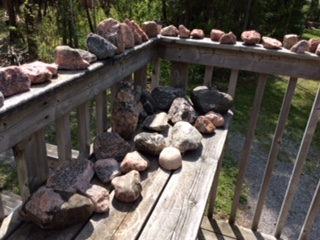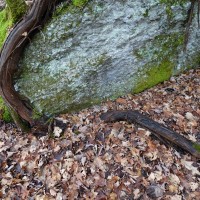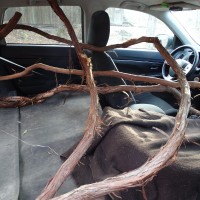Sandi McNeil is getting her rocks in a row to choose the perfect base for her wire trees. If you want to see what they look like with a tree wrapped around them, visit her page on our site at https://victoriacountystudiotour.com/sandi-mcneil/ She, Carol Nichol and Janet McDougall welcome you to their studio.
Archive for basketry
Spring is always a busy time of year, and in my basket weaving life it is even busier! All winter long I gather willow and vines, and soak many, many yards of bark, before happily constructing a large variety of spoked baskets. Once Spring arrives, I start to notice changes in the materials that I gather and use all winter. The willows sport pussy willows, quickly followed by leaves. The dogwood loses its lovely red colour, and the outside temperature starts getting pleasantly warmer. These are all signs that its time to put my basket weaving on hold and start to plan my once yearly, cedar bark gathering.
The arrival of spring means that it is time for me to refocus, and put my energy and time into replenishing my stock of cedar bark. Cedar bark can only be gathered during a short window of time anywhere from late April to late May. During this time, the sap is running in the bark, but it is not yet sticky. Sticky bark is hard to peel and separate, and who wants a sticky basket? This window of time is dependent on the warming temperatures of spring, so every year it is a guessing game to determine when to start peeling.
This year I have plans to make some trails on my property suitable for dog-sledding, and several cedars are in the way. If I don’t cut them down this spring and harvest the bark, those trees will be knocked down later this summer, and by then the bark will no longer be useful for basket making. So, I have been very busy cutting down and peeling cedar trees. This year I have the luxury of more time to spend gathering bark. I have been able to peel the bark from the tree and then immediately remove the outer bark from the inner bark while the bark is still moist and flexible. The outer bark is not useful, but the inner bark is well worth the time spent to gather and process it. Cedar bark peels off the tree in a lengthwise direction. When first peeled, the inner bark is a creamy white colour and feels wet and slippery, but not sticky. I remove the outer bark and coil each strip of inner bark and tuck in the ends to contain the coil. I then bundle the coils together and hang the bundle to dry in my studio. As it slowly dries out, the bark turns a golden honey colour, and becomes stiff and inflexible. In this state it can be stored in my studio for many years until I’m ready to use it.
Vines
Winter Rhythms:
Vines
I start with gathering vines. Gathering vine is always an adventure because sometimes the vine doesn’t want to let go of the tree. This is when it’s helpful to bring a strong friend. In fact there have been times when we have pulled down the tree in the process of pulling on the vine. In extreme cases for exceptionally large vines, a truck with 4 wheel drive and a long cable is necessary. Another extreme method is to chainsaw the tree down, carefully remove the vine, and then cut up the tree for fire wood. Once I have the vine at home I trim off any dead growth, or vine that is too thin to use. I spread the vines out on the ground and take notice of the kinds of shapes that are in the vines. Some would say that I let the vines speak to me. Often I will work from big to small when choosing which vine to work with. As I decide the shape of the basket frames, I tie the frames together as I go. If some vine is particularly wonky, I put the basket frame under something heavy to flatten it out and make it more symmetrical. I typically leave the frame for several weeks (or more) to dry out somewhat before I weave on it. I continue to work on vines for several days, until all the gathered vines have been used to form frames for different kinds of baskets. I stack the frames in the garage to dry out until I’m ready for the next steps.
Interview with Sandi McNeil
Braided cat tails, cherry red dog wood & woven tree bark – these are the materials used to weave baskets with Sandi McNeil of Earth and Vine.
Sandi leads workshops on basket weaving and wire tree sculpture making at a cozy studio space tucked away in the natural setting that is Kawartha Lakes. In the winter, warm cookies are served from atop the wooden stove that heats the studio. During the warmer months, when weather permits, workshops are held outside. Sandi encourages workshop participants to gather inspiration (and materials) from nature and there is no better place than Kawartha Lakes to do so.
Posted with permission by Kawarthas Northumberland on Wednesday, November 18, 2015
Copyright © 2024 All Rights Reserved
Designed by m. sullivan






